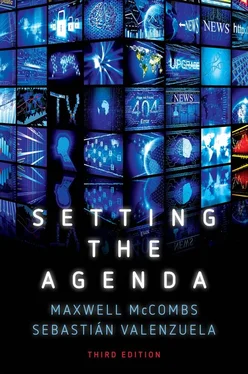A similar, parsimonious description of our situation vis-à-vis the news media is captured in sociologist Robert Park’s venerable phrase, the ‘signal function’ of the news. 2The daily news alerts us to the latest events and changes in the larger environment beyond our immediate experience. But the news media do considerably more than signal the existence of major events and issues. Through their selection and display of the news, journalists focus our attention and influence our perceptions of what are the most important issues of the day. This role of the news media in identifying the key issues and topics of the day and their ability to influence the salience of these issues and topics on the public agenda has come to be called the agenda-setting role of the news media.
News media communicate a host of cues about the relative salience of the topics on their daily agenda. The lead story on page 1 of a newspaper, the placement of a story on a website, the length of a story, even the number of social media interactions garnered by a story – all communicate the salience of topics on the news agenda. The television news agenda has a more limited capacity, so even a mention on the evening television news is a strong signal about the high salience of a topic. Additional cues are provided by its placement in the broadcast and by the amount of time spent on the story. For all the communication media, the repetition of a topic day after day is the most powerful message of all about its importance.
The public uses these salience cues from the media to organize its own agenda and decide which issues are most important. Over time, the issues emphasized in news reports become the issues regarded as most important among the public. The agenda of the news media becomes, to a considerable degree, the agenda of the public. In other words, the news media largely set the public agenda. Establishing this salience among the public, placing an issue, event, public figure, or other major element in the news on the public agenda so that it becomes the focus of public attention and thought – and, possibly, action – is the initial stage in the formation of public opinion.
Discussion of public opinion usually centres on the distribution of opinions: how many are for, how many are against, and how many are undecided. That is why the news media and so many news users are so fascinated with public opinion polls, especially during political campaigns. But, before we consider the distribution of opinions, we need to know which elements are at the centre of public opinion. People have opinions on many things, but only a few really matter to them. The agenda-setting role of the news media is their influence on the salience of an object of attention in the news, such as a controversial topic or a political candidate, an influence on whether a significant number of people regard it as worthwhile to hold an opinion about that object.
While many issues compete for public attention, only a few are successful in doing so, and the news media exert significant influence on our perceptions of what are the most important issues of the day. Within professional news outlets, this is not a deliberate, premeditated influence, as in the expression ‘to have an agenda’. Premeditated attempts at influence are the realm of the partisan media, propaganda, advertising, so-called ‘fake news’ sites, and other forms of communication that seek to persuade. 3Professional news media seek to inform, not persuade. And their agenda-setting role stems not from efforts at persuasion, but rather is an inadvertent influence resulting from the necessity of the news media to select and highlight a few topics in their reports about the most salient news of the moment.
This distinction between the influence of the professional news media on the salience of objects in the news and on specific opinions about these objects is summed up in Bernard Cohen’s observation that the news media may not be successful in telling people what to think, but they are stunningly successful in telling their audiences what to think about. 4In other words, the news media can set the agenda for public thought and discussion. Sometimes the news media do more than this. Other times, the news media fail at setting the public agenda. Hence, we will find it necessary in later chapters to expand on Cohen’s cogent observation. But first, let us consider in some detail the initial step in the formation of public opinion, capturing public attention.
Our pictures of the world
Walter Lippmann is the intellectual father of the idea now called, for short, agenda setting. The opening chapter of his 1922 classic, Public Opinion , is titled ‘The World Outside and the Pictures in our Heads’, and summarizes the agenda-setting idea even though Lippmann did not use that phrase. His thesis is that the news media, our windows to the vast world beyond direct experience, determine our cognitive maps of that world. Public opinion, argued Lippmann, responds not to the environment, but to the pseudo-environment constructed by the news media.
Still in print nearly a century after its original publication, Public Opinion presents an intriguing array of anecdotal evidence to support its thesis. Lippmann begins the book with a compelling story of ‘an island in the ocean where in 1914 a few Englishmen, Frenchmen, and Germans lived’. Only the arrival of the mail steamer more than six weeks after the outbreak of the First World War alerted these friends to the fact that they were enemies. 5For Lippmann, who was writing in the 1920s, these are contemporary updates of Plato’s Allegory of the Cave, with which he prefaces the book. Paraphrasing Socrates, he noted ‘how indirectly we know the environment in which nevertheless we live […] but that whatever we believe to be a true picture, we treat as if it were the environment itself’. 6
Contemporary empirical evidence
Empirical evidence about the agenda-setting role of the communication media now confirms and elaborates Lippmann’s broad-brush observations. When agenda setting was first proposed, it ran counter to the prevailing paradigm among communication scholars that the mass media had limited effects in changing people’s perceptions and attitudes. Agenda setting, on the contrary, showed that the news media can have strong, direct effects in the short term by influencing not what people think, but what they think about.
However, the empirical currency of agenda setting as a theory about the formation of public opinion came much later than Lippmann’s essay. When Public Opinion was published in 1922, the first scientific investigations of the influence of mass communication on public opinion were still more than a decade in the future. Publication of the first explicit investigation of the agenda-setting role of mass communication was exactly fifty years away.
Systematic analysis of mass communication’s effects on public opinion, empirical research grounded in the precepts of scientific investigation, dates from the 1940 US presidential election, when sociologist Paul Lazarsfeld and his colleagues at Columbia University, in collaboration with pollster Elmo Roper, conducted seven rounds of interviews with voters in Erie County, Ohio. 7Contrary to both popular and scholarly expectations, these surveys and many subsequent investigations in other settings over the next twenty years found little evidence of mass communication effects on attitudes and opinions. Two decades after Erie County, Joseph Klapper’s The Effects of Mass Communication declared that the so-called Law of Minimal Consequences prevailed: ‘Mass communication ordinarily does not serve as a necessary and sufficient cause of audience effects, but rather functions among and through a nexus of mediating functions and influences.’ 8
Читать дальше












